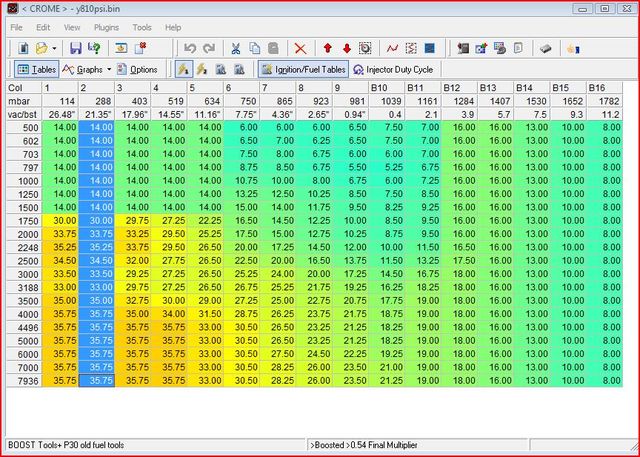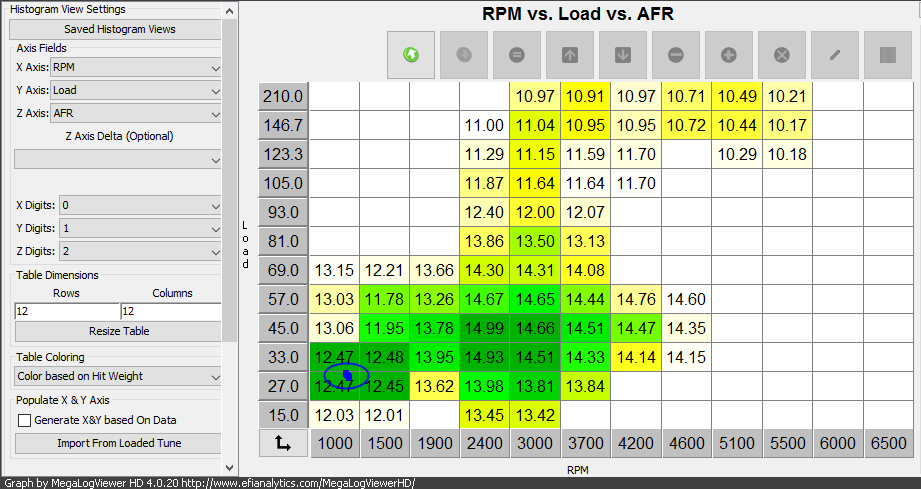Auto Tune Accept Tables
The TT-Auto Tune application generates air/fuel corrections to the VE tables which can be exported back into the tune, once exported the tune reverts back to live closed loop operation. Instructions for the Auto Tune process can be found here. May 04, 2018 There are some older maps that do not have any values in the AFR table; you will have to fill those in yourself. Most naturally aspirated four stroke engines, running pump gasoline, make the best horsepower at an AFR between 12.8 – 13.4; and get the best fuel economy around 14.7 AFR.
What is Target Tune:
Target Tune is an add on module for Dynojet Power Vision that uses a control module and 2 Bosch wideband AFR / Lambda sensors integrating them into the H-D Delphi ECM. It uses the existing closed loop, adaptive fuel control strategy in your Delphi ECM, but with changes made to the calibration to allow your ECM to use the wideband sensors, it is a plug in kit into the factory connectors. In order for the system to work, you must have a Target Tune enabled calibration flashed to your bike with the various edits required to make it work. Fuel Moto or a Dynojet technical representative can supply Target Tune enabled maps or make the necessary edits to your existing tune.
So my ECM is now able to use wideband o2 sensors on the fly?
Yes, your ECM has now been configured to use wideband O2 data and use them for closed loop control based on the AFR/Lambda targets in your fuel table using short term & long term fuel trims.

What should I expect?
Your bike will perform better once the various thresholds to allow closed loop fuel control are met, things like engine temp, etc etc. It will run at the target AFR or Lambda defined in your calibration’s fuel table even if your VE tables are not perfect by using both short term & long term fuel trims.

Can I make changes to my tune?
Yes, all the regular tuning parameters that are exposed to you in WinPV are available.
So if I change the values in my fuel table, my bike will actually run at those AFR or Lambda values?
Yes. Fuel Moto or Dynojet will set up your fuel table for best results, but you can edit these values to suit your needs.
Can I use the Target Tune module for the AutoTune process?
Absolutely, the Target Tune module works excellent for the AutoTune function and it has its own Target Tune-Auto Tune mode. When enabling Auto Tune you will select, “Dynojet Target Tuner Wideband Kit” when starting an Autotune session. The TT-Auto Tune application generates air/fuel corrections to the VE tables which can be exported back into the tune, once exported the tune reverts back to live closed loop operation. Instructions for the Auto Tune process can be found here.
Auto Tune Accept Tables Near Me
How can I turn off Target Tune?
You can load a tune that doesn’t have Target Tune enabled (you will have to reinstall the factory O2 sensors), or you can use Quick Tune to turn off closed loop.
What is the adjustment range for Target Tune?
Target Tune calibrations are generally set up to subtract 30%, and add 40% fuel to a tune. Your tuner can adjust these values if need be,
How can I tell if Target Tune is working?
At any given operating condition there is an AFR, or Lambda value the ECM is trying to achieve. To watch live corrections (short term fuel trims) with your Power Vision you can view the channels Front & Rear Closed Loop Integrator (CLI), these are a +/- multiplier of the live fuel corrections as a %, for stored corrections (long term fuel trims) you can view Front & Rear Adaptive Fuel Factor (AFF). You can also monitor WBO2 for the Vehicle Signals for real time AFR or Lambda on your Power Vision while riding, or create a datalog to verify. There are also other channels that can be monitored, or logged that would give you an indication that Target Tune is online and the ECM is using it accordingly.
How do I setup the channels?

Select “Datalog” from the main menu, then “Gauges”. Select the style of gauges you’d like to work by scrolling left or right. Tap the gauge to assign a channel, and the “Set Gauge Properties” dialog will appear. Tap the field that says “None” and then choose the source and the channel you’re interested in. You’ll also need to change from “Basic Signals” to “Advanced Signals” by tapping the “Change” button.
- To monitor AFR or Lambda from the Target Tune:
Choose “Vehicle” from the “Select Signal Source” screen. Select WBO2 AFR Front and Rear, or WBO2 LAMBDA Front and Rear.
- Like any “closed loop calibration”, the Closed Loop Integrator (CLI-short term fuel trim) should be active during normal riding conditions. This value should constantly swing up and down constantly, where the value of 100 is the “pivot point”. For example if a CLI value of 103 is reported, that means the ECM had to add 3% to the respective front or rear cylinder VE table in order to achieve the target AFR or Lambda. Conversely, the value of 97 would indicate the ECM had to subtract 3% to the respective front or rear cylinder VE table in order to achieve the target AFR or Lambda. To view these channels, assign them to a gauge. You’re looking for “Front Closed Loop Integrator” and “Rear Closed Loop Integrator”.
Auto Tune Accept Tables 2017
- If you have Adaptive Fuel enabled in your calibration, then you should also notice Adaptive Fuel Factor (AFF) change over time. These learned values will move, or change much slower than the CLI. When the proper conditions have been met the ECM will generate long term/long term fuel trims (AFF). If you see a AFF value of 105 reported, that means the ECM has applied 5% to the respective front or rear cylinder VE table in order to achieve the target AFR or Lambda. Conversely, the value of 95 would indicate the ECM had to subtract 5% to the respective front or rear cylinder VE table in order to achieve the target AFR or Lambda. To view these channels, assign them to a gauge. You’re looking for “Front Adaptive Fuel Factor” and “Rear Adaptive Fuel Factor”
How does Target Tune AutoTune process work?
Utilizing the Target Tune AFR data and other data from the H-D OEM data bus, the Power Vision can automatically fix the deviation between the AFR or Lambda as defined in the fuel table of your calibration and the actual AFR or Lambda by adjusting the VE tables. The data is learned in real time, but processing the data and adjusting the tune is done in an “offline state” (key on/engine off). After the data is collected, the Power Vision can process the data, correct the tune, and then re-flash the corrected tune into the ECM. You’ve effectively corrected the VE tables to ensure the AFR or Lambda you ask for (in your calibration) is what you get (as measured by the wideband o2 sensors). Once you exit the Autotune mode you’ll be back to using your full-time, Target Tune closed loop calibration. There are full instructions on the Auto Tune process located here
Auto Tune Accept Tables Online
What happens if there is a problem with Target Tune? The OEM diagnostic system is still fully functional, and in the event there was an issue a DTC would be set. You can use the Power Vision to read the DTC like normal. If the module, sensor, or harness were to fail the ECM would transition into open loop, just like if your OEM narrowband sensor were to fail.